engine MAZDA MODEL 6 2005 (in English) Owner's Guide
[x] Cancel search | Manufacturer: MAZDA, Model Year: 2005, Model line: MODEL 6, Model: MAZDA MODEL 6 2005Pages: 340, PDF Size: 3.73 MB
Page 137 of 340
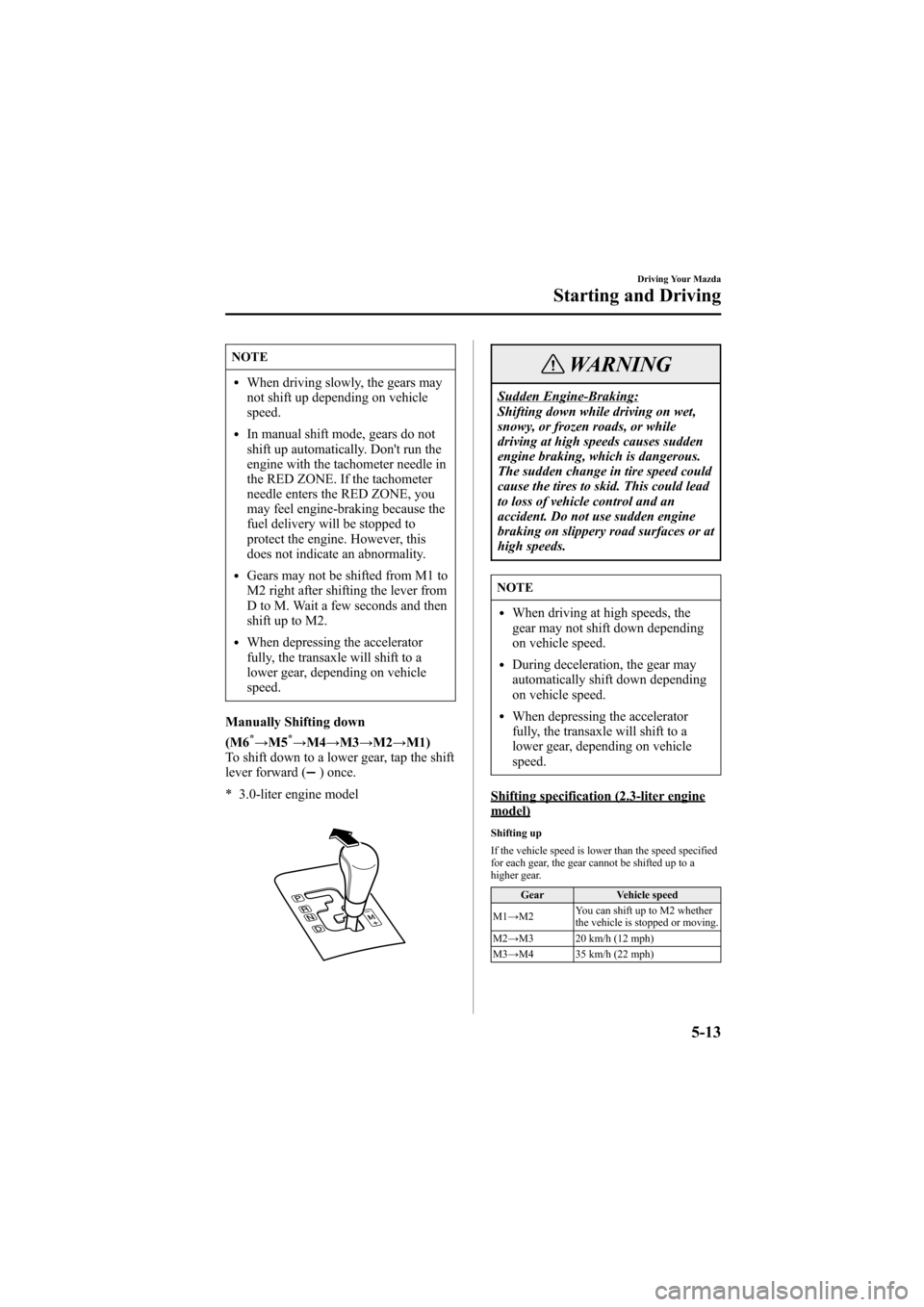
Black plate (137,1)
NOTE
lWhen driving slowly, the gears may
not shift up depending on vehicle
speed.
lIn manual shift mode, gears do not
shift up automatically. Don't run the
engine with the tachometer needle in
the RED ZONE. If the tachometer
needle enters the RED ZONE, you
may feel engine-braking because the
fuel delivery will be stopped to
protect the engine. However, this
does not indicate an abnormality.
lGears may not be shifted from M1 to
M2 right after shifting the lever from
D to M. Wait a few seconds and then
shift up to M2.
lWhen depressing the accelerator
fully, the transaxle will shift to a
lower gear, depending on vehicle
speed.
Manually Shifting down
(M6
*→M5*→M4→M3→M2→M1)
To shift down to a lower gear, tap the shift
lever forward (
) once.
* 3.0-liter engine model
WARNING
Sudden Engine-Braking:
Shifting down while driving on wet,
snowy, or frozen roads, or while
driving at high speeds causes sudden
engine braking, which is dangerous.
The sudden change in tire speed could
cause the tires to skid. This could lead
to loss of vehicle control and an
accident. Do not use sudden engine
braking on slippery road surfaces or at
high speeds.
NOTE
lWhen driving at high speeds, the
gear may not shift down depending
on vehicle speed.
lDuring deceleration, the gear may
automatically shift down depending
on vehicle speed.
lWhen depressing the accelerator
fully, the transaxle will shift to a
lower gear, depending on vehicle
speed.
Shifting specification (2.3-liter enginemodel)
Shifting up
If the vehicle speed is lower than the speed specified
for each gear, the gear cannot be shifted up to a
higher gear.
Gear Vehicle speed
M1→M2You can shift up to M2 whether
the vehicle is stopped or moving.
M2→M3 20 km/h (12 mph)
M3→M4 35 km/h (22 mph)
Driving Your Mazda
Starting and Driving
5-13
Mazda6_8T56-EC-04G_Edition2 Page137
Monday, November 15 2004 4:33 PM
Form No.8T56-EC-04G
Page 138 of 340

Black plate (138,1)
Shifting down
If the vehicle speed is higher than the speed specified
for each gear, the gear cannot be shifted down to a
lower gear.
Gear Vehicle speed
M4→M3 147 km/h (91 mph)
M3→M2 104 km/h (64 mph)
M2→M1 44 km/h (27 mph)
During deceleration, the gears shift down
automatically when speed is reduced to the
following:
Gear Vehicle speed
M4→M3 31 km/h (19 mph)
M3 or M2→M1 12 km/h (7 mph)
NOTE
If the vehicle is driven at a low speed
from a standing start while in M2, the
gear may not shift down to M1
automatically.
If the vehicle is kicked down at the following speeds
or lower, the gears shift down automatically:
Gear Vehicle speed
M4→M3 140 km/h (86 mph)
M3→M2 56 km/h (34 mph)
Shifting specification (3.0-liter enginemodel)
Shifting up
If the vehicle speed is lower than the speed specified
for each gear, the gear cannot be shifted up to a
higher gear.
Gear Vehicle speed
M1→M2You can shift up to M2 whether
the vehicle is stopped or moving.
M2→M3 10 km/h (6 mph)
M3→M4 23 km/h (14 mph)
M4→M5 39 km/h (24 mph)
M5→M6 49 km/h (30 mph)Shifting down
If the vehicle speed is higher than the speed specified
for each gear, the gear cannot be shifted down to a
lower gear.
Gear Vehicle speed
M5→M4 175 km/h (109 mph)
M4→M3 130 km/h (81 mph)
M3→M2 83 km/h (52 mph)
M2→M1 43 km/h (27 mph)
During deceleration, the gears shift down
automatically when speed is reduced to the
following:
Gear Vehicle speed
M6→M5Between 50 and 212 km/h
(31 and 131 mph), depending on
how much the accelerator pedal
is released.
M5→M4Between 38 and 161 km/h
(23 and 100 mph), depending on
how much the accelerator pedal
is released.
M4→M3Between 23 and 70 km/h
(14 and 44 mph), depending on
how much the accelerator pedal
is released.
M3→M2Between 10 and 46 km/h
(6 and 28 mph), depending on
how much the accelerator pedal
is released.
M2→M1 10 km/h (6 mph)
NOTE
If the vehicle is driven at a low speed
from a standing start while in M2, the
gear may not shift down to M1
automatically.
5-14
Driving Your Mazda
Starting and Driving
Mazda6_8T56-EC-04G_Edition2 Page138
Monday, November 15 2004 4:33 PM
Form No.8T56-EC-04G
Page 139 of 340
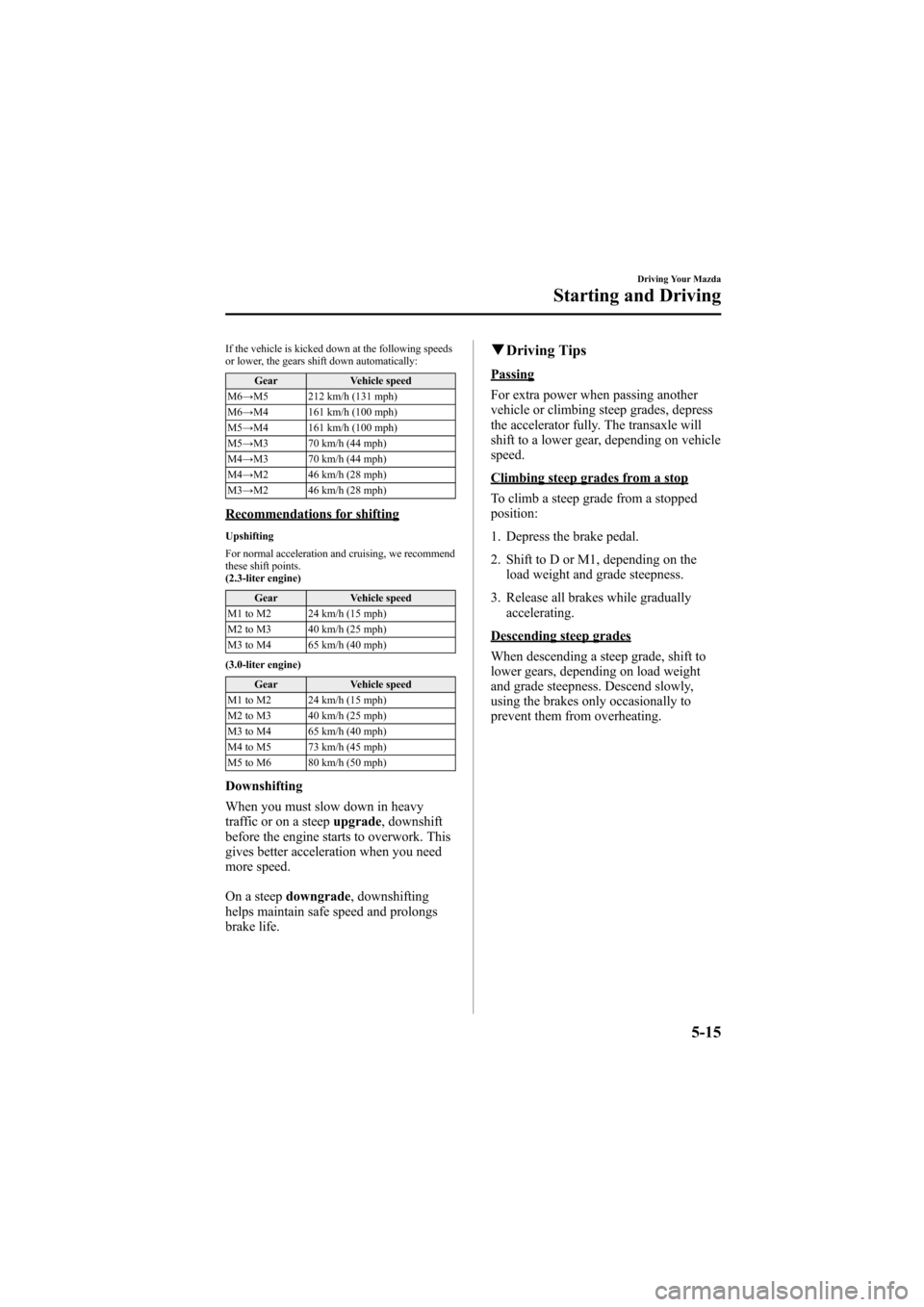
Black plate (139,1)
If the vehicle is kicked down at the following speeds
or lower, the gears shift down automatically:
Gear Vehicle speed
M6→M5 212 km/h (131 mph)
M6→M4 161 km/h (100 mph)
M5→M4 161 km/h (100 mph)
M5→M3 70 km/h (44 mph)
M4→M3 70 km/h (44 mph)
M4→M2 46 km/h (28 mph)
M3→M2 46 km/h (28 mph)
Recommendations for shifting
Upshifting
For normal acceleration and cruising, we recommend
these shift points.
(2.3-liter engine)
Gear Vehicle speed
M1 to M2 24 km/h (15 mph)
M2 to M3 40 km/h (25 mph)
M3 to M4 65 km/h (40 mph)
(3.0-liter engine)
Gear Vehicle speed
M1 to M2 24 km/h (15 mph)
M2 to M3 40 km/h (25 mph)
M3 to M4 65 km/h (40 mph)
M4 to M5 73 km/h (45 mph)
M5 to M6 80 km/h (50 mph)
Downshifting
When you must slow down in heavy
traffic or on a steepupgrade, downshift
before the engine starts to overwork. This
gives better acceleration when you need
more speed.
On a steepdowngrade, downshifting
helps maintain safe speed and prolongs
brake life.
qDriving Tips
Passing
For extra power when passing another
vehicle or climbing steep grades, depress
the accelerator fully. The transaxle will
shift to a lower gear, depending on vehicle
speed.
Climbing steep grades from a stop
To climb a steep grade from a stopped
position:
1. Depress the brake pedal.
2. Shift to D or M1, depending on the
load weight and grade steepness.
3. Release all brakes while gradually
accelerating.
Descending steep grades
When descending a steep grade, shift to
lower gears, depending on load weight
and grade steepness. Descend slowly,
using the brakes only occasionally to
prevent them from overheating.
Driving Your Mazda
Starting and Driving
5-15
Mazda6_8T56-EC-04G_Edition2 Page139
Monday, November 15 2004 4:33 PM
Form No.8T56-EC-04G
Page 140 of 340
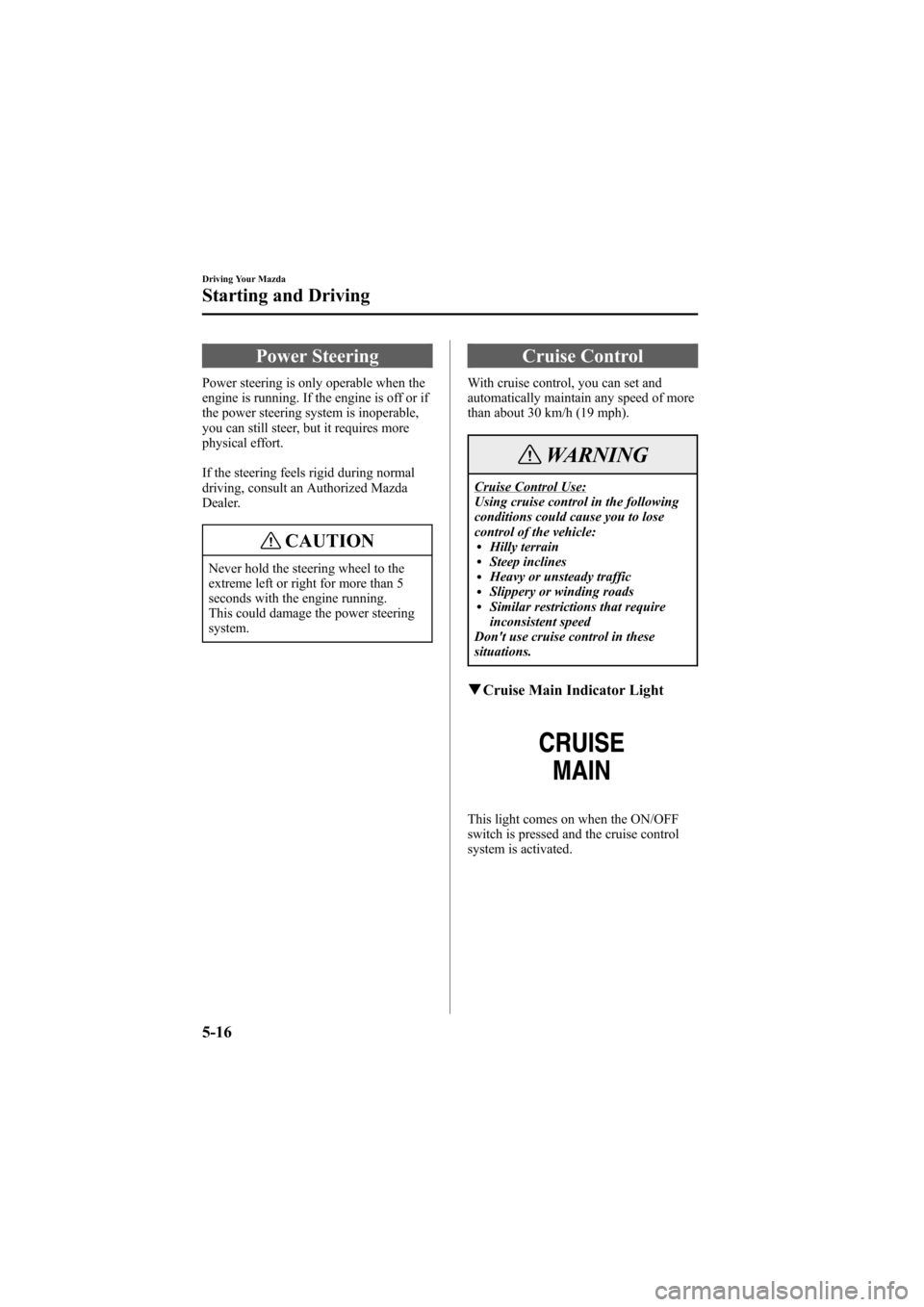
Black plate (140,1)
Power Steering
Power steering is only operable when the
engine is running. If the engine is off or if
the power steering system is inoperable,
you can still steer, but it requires more
physical effort.
If the steering feels rigid during normal
driving, consult an Authorized Mazda
Dealer.
CAUTION
Never hold the steering wheel to the
extreme left or right for more than 5
seconds with the engine running.
This could damage the power steering
system.
Cruise Control
With cruise control, you can set and
automatically maintain any speed of more
than about 30 km/h (19 mph).
WARNING
Cruise Control Use:
Using cruise control in the following
conditions could cause you to lose
control of the vehicle:
lHilly terrainlSteep inclineslHeavy or unsteady trafficlSlippery or winding roadslSimilar restrictions that require
inconsistent speed
Don't use cruise control in these
situations.
qCruise Main Indicator Light
This light comes on when the ON/OFF
switch is pressed and the cruise control
system is activated.
5-16
Driving Your Mazda
Starting and Driving
Mazda6_8T56-EC-04G_Edition2 Page140
Monday, November 15 2004 4:33 PM
Form No.8T56-EC-04G
Page 144 of 340
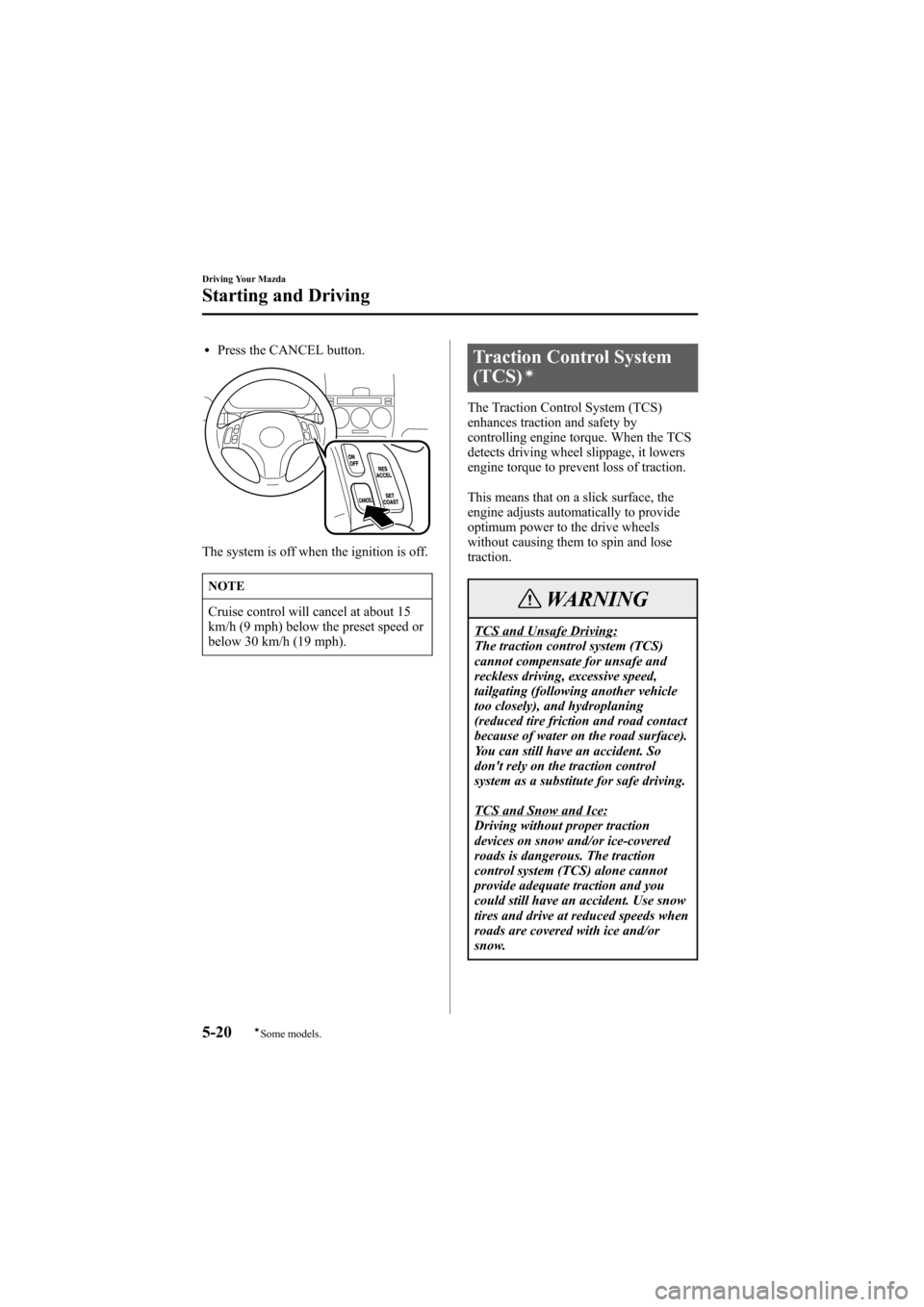
Black plate (144,1)
lPress the CANCEL button.
The system is off when the ignition is off.
NOTE
Cruise control will cancel at about 15
km/h (9 mph) below the preset speed or
below 30 km/h (19 mph).
Traction Control System
(TCS)í
The Traction Control System (TCS)
enhances traction and safety by
controlling engine torque. When the TCS
detects driving wheel slippage, it lowers
engine torque to prevent loss of traction.
This means that on a slick surface, the
engine adjusts automatically to provide
optimum power to the drive wheels
without causing them to spin and lose
traction.
WARNING
TCS and Unsafe Driving:
The traction control system (TCS)
cannot compensate for unsafe and
reckless driving, excessive speed,
tailgating (following another vehicle
too closely), and hydroplaning
(reduced tire friction and road contact
because of water on the road surface).
You can still have an accident. So
don't rely on the traction control
system as a substitute for safe driving.
TCS and Snow and Ice:
Driving without proper traction
devices on snow and/or ice-covered
roads is dangerous. The traction
control system (TCS) alone cannot
provide adequate traction and you
could still have an accident. Use snow
tires and drive at reduced speeds when
roads are covered with ice and/or
snow.
5-20
Driving Your Mazda
íSome models.
Starting and Driving
Mazda6_8T56-EC-04G_Edition2 Page144
Monday, November 15 2004 4:33 PM
Form No.8T56-EC-04G
Page 145 of 340
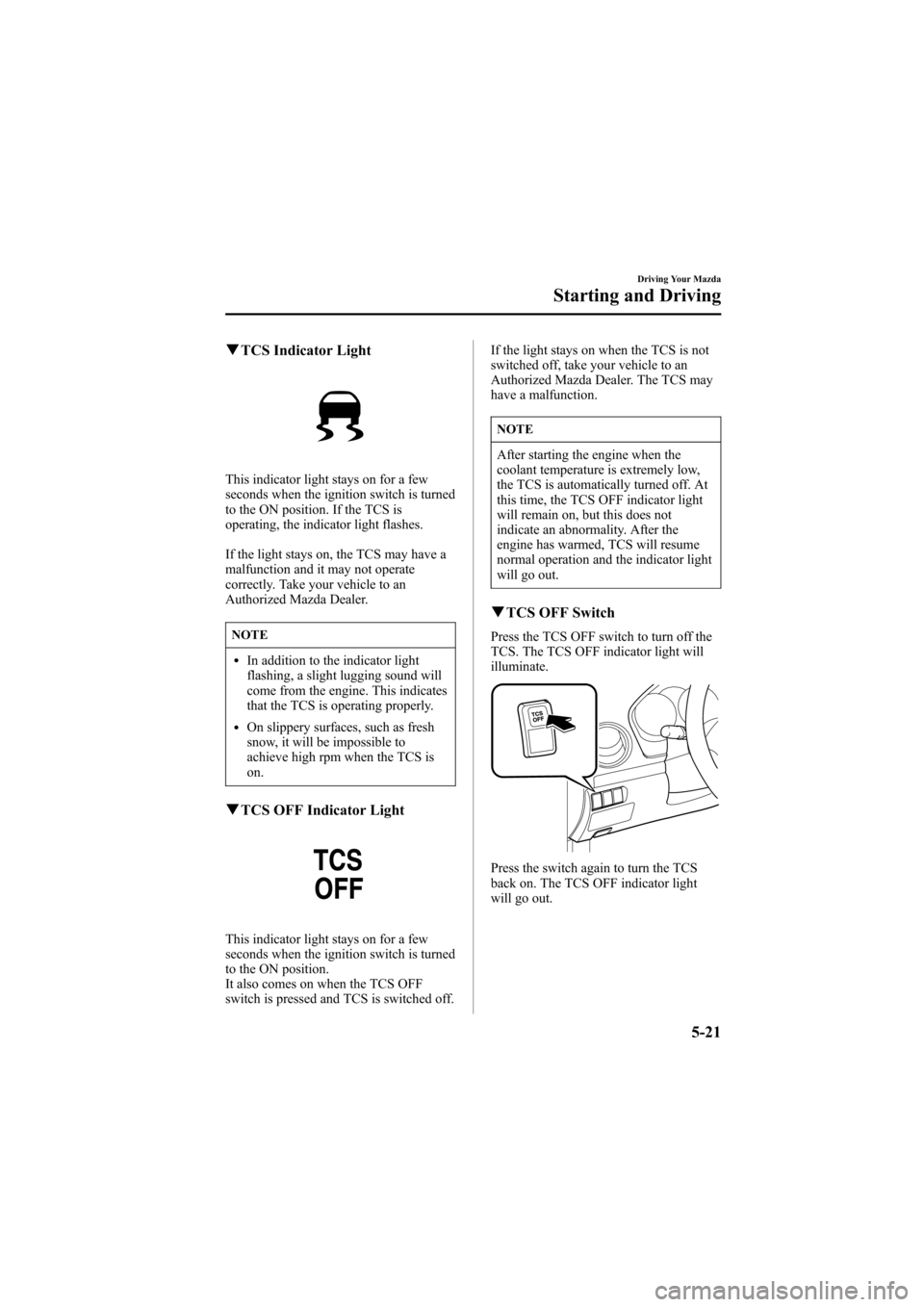
Black plate (145,1)
qTCS Indicator Light
This indicator light stays on for a few
seconds when the ignition switch is turned
to the ON position. If the TCS is
operating, the indicator light flashes.
If the light stays on, the TCS may have a
malfunction and it may not operate
correctly. Take your vehicle to an
Authorized Mazda Dealer.
NOTE
lIn addition to the indicator light
flashing, a slight lugging sound will
come from the engine. This indicates
that the TCS is operating properly.
lOn slippery surfaces, such as fresh
snow, it will be impossible to
achieve high rpm when the TCS is
on.
qTCS OFF Indicator Light
This indicator light stays on for a few
seconds when the ignition switch is turned
to the ON position.
It also comes on when the TCS OFF
switch is pressed and TCS is switched off.If the light stays on when the TCS is not
switched off, take your vehicle to an
Authorized Mazda Dealer. The TCS may
have a malfunction.
NOTE
After starting the engine when the
coolant temperature is extremely low,
the TCS is automatically turned off. At
this time, the TCS OFF indicator light
will remain on, but this does not
indicate an abnormality. After the
engine has warmed, TCS will resume
normal operation and the indicator light
will go out.
qTCS OFF Switch
Press the TCS OFF switch to turn off the
TCS. The TCS OFF indicator light will
illuminate.
Press the switch again to turn the TCS
back on. The TCS OFF indicator light
will go out.
Driving Your Mazda
Starting and Driving
5-21
Mazda6_8T56-EC-04G_Edition2 Page145
Monday, November 15 2004 4:33 PM
Form No.8T56-EC-04G
Page 146 of 340

Black plate (146,1)
NOTE
lWhen TCS is on and you attempt to
free the vehicle when it is stuck, or
drive it out of freshly fallen snow,
the TCS will activate. Depressing the
accelerator will not increase engine
power and freeing the vehicle may
be difficult. When this happens, turn
off the TCS.
lIf the TCS is off when the engine is
turned off, it automatically activates
when the ignition switch is turned
on.
lLeaving the TCS on will provide the
best traction.
5-22
Driving Your Mazda
Starting and Driving
Mazda6_8T56-EC-04G_Edition2 Page146
Monday, November 15 2004 4:33 PM
Form No.8T56-EC-04G
Page 147 of 340
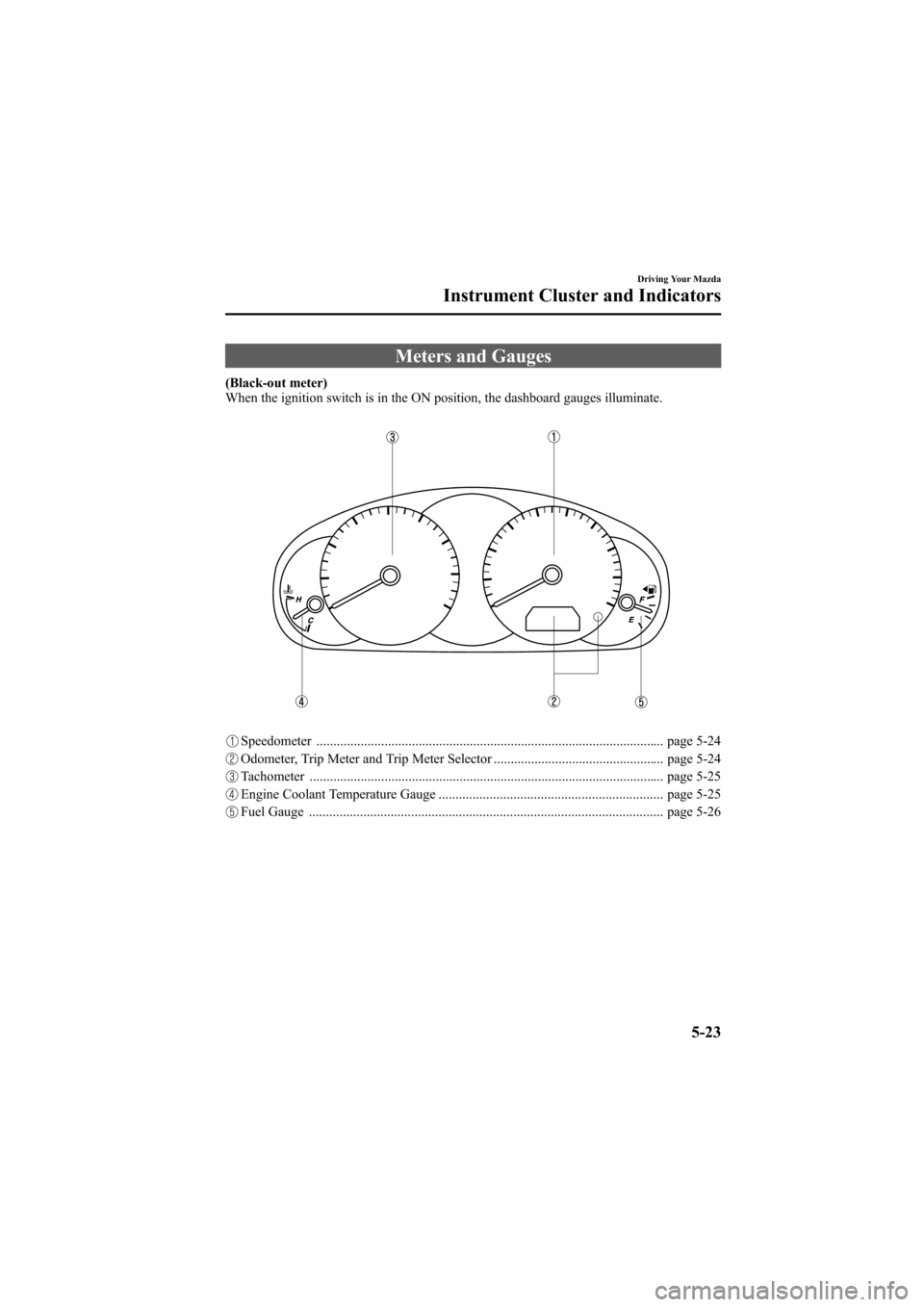
Black plate (147,1)
Meters and Gauges
(Black-out meter)
When the ignition switch is in the ON position, the dashboard gauges illuminate.
Speedometer ...................................................................................................... page 5-24
Odometer, Trip Meter and Trip Meter Selector .................................................. page 5-24
Tachometer ........................................................................................................ page 5-25
Engine Coolant Temperature Gauge .................................................................. page 5-25
Fuel Gauge ........................................................................................................ page 5-26
Driving Your Mazda
Instrument Cluster and Indicators
5-23
Mazda6_8T56-EC-04G_Edition2 Page147
Monday, November 15 2004 4:33 PM
Form No.8T56-EC-04G
Page 149 of 340
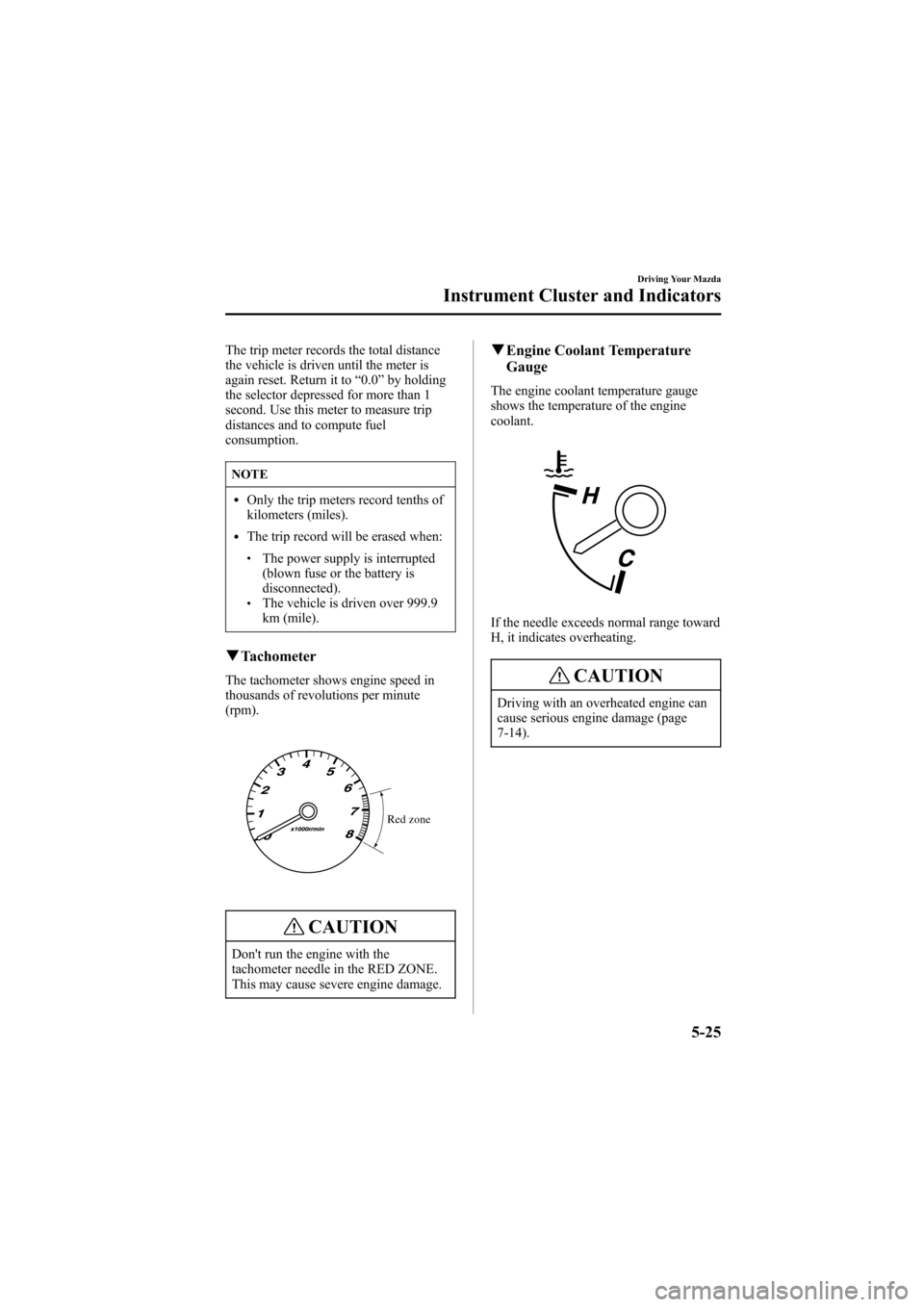
Black plate (149,1)
The trip meter records the total distance
the vehicle is driven until the meter is
again reset. Return it to“0.0”by holding
the selector depressed for more than 1
second. Use this meter to measure trip
distances and to compute fuel
consumption.
NOTE
lOnly the trip meters record tenths of
kilometers (miles).
lThe trip record will be erased when:
lThe power supply is interrupted
(blown fuse or the battery is
disconnected).
lThe vehicle is driven over 999.9
km (mile).
qTachometer
The tachometer shows engine speed in
thousands of revolutions per minute
(rpm).
Red zone
CAUTION
Don't run the engine with the
tachometer needle in the RED ZONE.
This may cause severe engine damage.
qEngine Coolant Temperature
Gauge
The engine coolant temperature gauge
shows the temperature of the engine
coolant.
If the needle exceeds normal range toward
H, it indicates overheating.
CAUTION
Driving with an overheated engine can
cause serious engine damage (page
7-14).
Driving Your Mazda
Instrument Cluster and Indicators
5-25
Mazda6_8T56-EC-04G_Edition2 Page149
Monday, November 15 2004 4:33 PM
Form No.8T56-EC-04G
Page 151 of 340
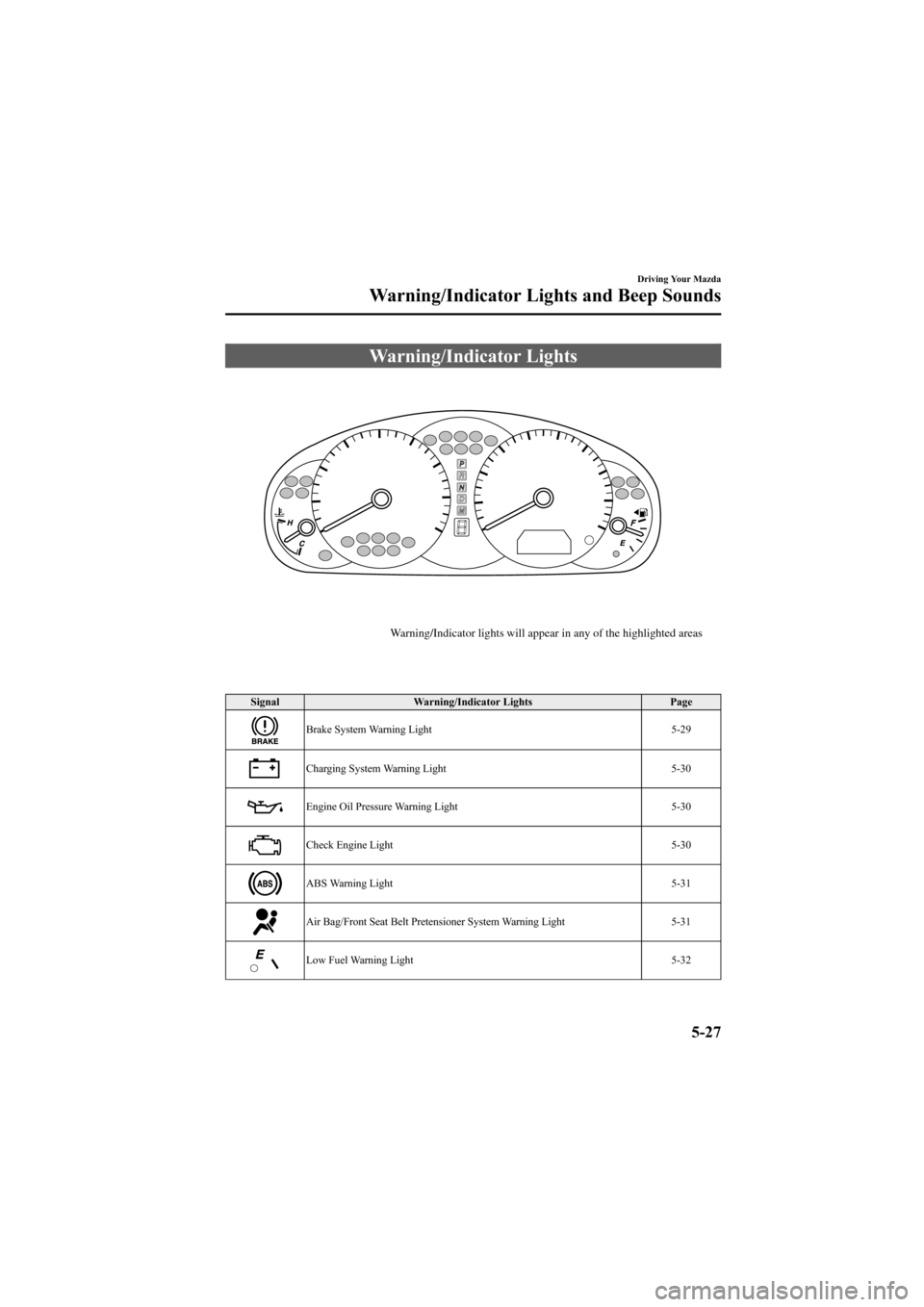
Black plate (151,1)
Warning/Indicator Lights
Warning/Indicator lights will appear in any of the highlighted areas
Signal Warning/Indicator Lights Page
Brake System Warning Light 5-29
Charging System Warning Light 5-30
Engine Oil Pressure Warning Light 5-30
Check Engine Light 5-30
ABS Warning Light 5-31
Air Bag/Front Seat Belt Pretensioner System Warning Light 5-31
Low Fuel Warning Light 5-32
Driving Your Mazda
Warning/Indicator Lights and Beep Sounds
5-27
Mazda6_8T56-EC-04G_Edition2 Page151
Monday, November 15 2004 4:33 PM
Form No.8T56-EC-04G